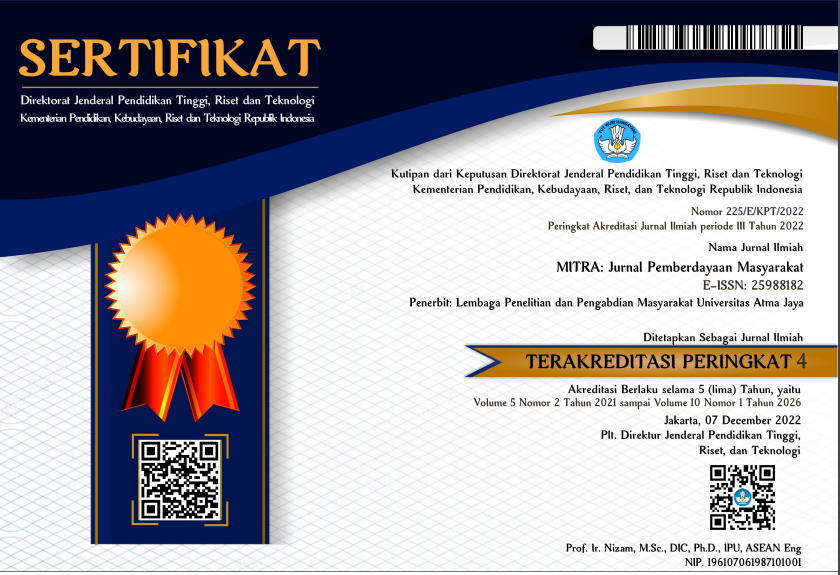Empowering the Youths through the Skilled Youth Program III as Citi Indonesia's Corporate Social Responsibility Activity
DOI:
https://doi.org/10.25170/mitra.v4i2.1295Keywords:
economic growth, youth empowerment, unemploymentAbstract
Decent Work and Economic Growth represent one of the goals of Sustainable Development Goals. The Government of Indonesia through the National Secretariat for Sustainable Development Goals has continued to launch national actions by building multi-stakeholder partnerships to encourage the achievement of these goals. Citi Indonesia, together with Indonesia Business Links, initiated a youth development and empowerment program in the area of Bekasi City, Bekasi Regency, Karawang Regency, Purwakarta Regency, and Bandung Regency. The collaboration was a Citi Indonesia Corporate Social Responsibility activity focusing on capacity building, opening job opportunities, encouraging entrepreneurship, and creating a conducive environment. Increased competence in human resources is needed especially in the current 4.0 industrial revolution era. The shift of human labour into machines with automation and the digital economy requires workers who have the intermediate ability. This happens because much low-skilled human labour has been replaced by machines. The program aimed to prepare young people to be ready to work and ready for entrepreneurship. This program was designed as a series of activities with implementation methods in the form of focus group discussions, outreach, in-class training, seminars, counselling, and field practice. The results showed an increase in the knowledge and skills of the training participants so that it is hoped they will have a greater opportunity to be employed or to become entrepreneurs.
References
BPS. (2019). Proyeksi penduduk menurut kabupaten/kota di Jawa Barat, 2010-2018. Badan Pusat Statistik.
Danial, A., Darusman, Y., Mustakim, M., & Herwina, W. (2019). Model pemberdayaan masyarakat melalui pola magang tradisional dalam upaya peningkatan wirausaha masyarakat. Jurnal Inovasi Hasil Pengabdian Masyarakat (JIPEMAS), 2(1), 31–48.
Disas, E. P. (2018). Link and match sebagai kebijakan pendidikan kejuruan. Jurnal Penelitian Pendidikan, 18(2), 231–242.
Faqihantara, I. (2019). TOR radio show pemberdayaan kaum muda sebagai bagian dari CSR di bidang ketenagakerjaan dalam mencapai tujuan ke-8 dari Sustainable Development Goals (Tujuan Pembangunan Berkelanjutan).
Faqihantara, I., & Wisesa, A. (2019). Siaran pers Citi Indonesia bersama Indonesia Business Links dorong peningkatan kompetensi bagi generasi muda untuk mencapai kemandirian finansial.
Ife, J. (2013). Community development in an uncertain world. Cambridge University Press.
Indaryatno, A., & Trisnamansyah, S. (2019). Manajemen revitalisasi sekolah menengah kejuruan dalam upaya meningkatkan mutu lulusan. Nusantara Education Review, 2(3), 277–286.
Indonesia Business Links. (2019). About Us - Indonesia Business Links. Indonesia Business Links. https://ibl.or.id.
Mankiw, N. G. (2007). Makroekonomi, edisi 6. Jakarta: Erlangga.
Rizal, S. (2020). PKM: Pemberdayaan generasi muda melalui enterpreneurship di Gampong Leuge Kecamatan Peureulak Kabupaten Aceh Timur. TRIDARMA:Pengabdian Kepada Masyarakat (PkM), 3(1), 35–39.
Suharto, E. (2005). Membangun masyarakat memberdayakan rakyat kajian strategis pembangunan kesejahteraan sosial dan pekerjaan sosial. Bandung: Refika Aditama.
Downloads
Published
How to Cite
Issue
Section
License
This license allows reusers to distribute, remix, adapt, and build upon the material in any medium or format for noncommercial purposes only, and only so long as attribution is given to the creator. If you remix, adapt, or build upon the material, you must license the modified material under identical terms.







_.jpeg)




.png)
2.png)
.png)
.png)



